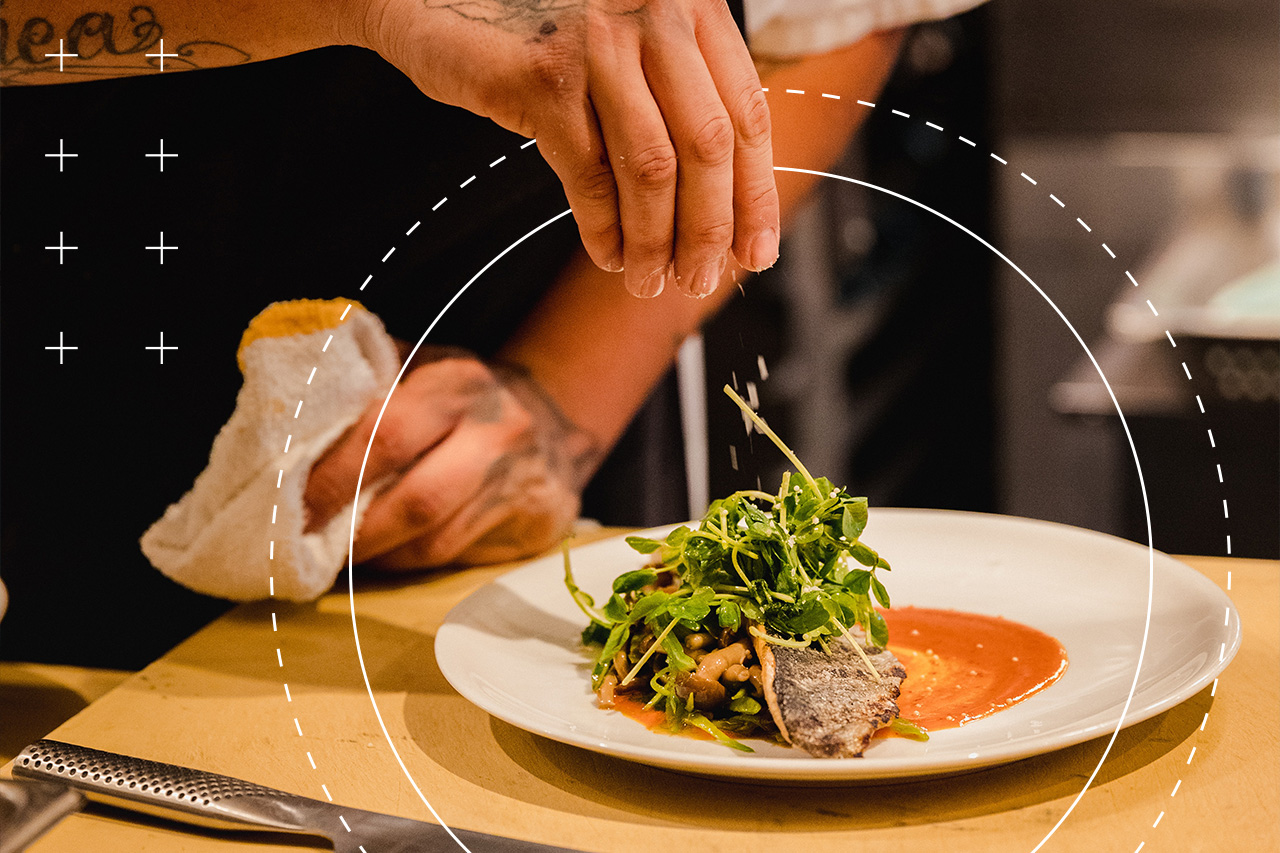Explore how the latest food marketing trends in sustainability, social media, and e-commerce are shaping the future of the industry.
Staying ahead of the curve in the crowded food marketing industry is more than strategic, it's a necessity. This blog explores three specific, influential food industry trends for food & beverage companies to consider when planning their marketing efforts: Sustainability, social media, and the evolution of e-commerce and delivery services.
Join us as we cover the trends shaping the present and future of food marketing. The table is set, and the trends are fresh — let’s dive into the prep work to create fantastic marketing for the food and beverage industry.
Sustainability: Nourishing the Planet and the Consumer
Some may consider “sustainability” to be a culinary buzzword like gluten-free, whole foods, or functional foods, but just like those terms, sustainability is a driving force in reshaping the food industry. From climate-conscious consumer choices to brands prioritizing eco-friendly practices, industry shifts toward sustainable food business are transforming how we produce, consume, and market food.
Eco-Friendly Consumption Patterns
The concept of sustainability transcends “trending” status, and is quickly becoming a guiding principle for both consumers and businesses. Now more than ever, consumers are making conscious choices about the environmental impact of their food waste and choices. The pandemic prompted reflections on our global food footprint and consumers are leaning toward supporting brands that prioritize sustainable practices in their businesses and food marketing strategies.
Plant-Based Paradigm Shift
The interest in plant-based foods is surging as a result of the desire for sustainability in food businesses. Diets are evolving, and plant-based alternatives are gaining popularity with broader American and global consumer bases. This shift is a response to both health considerations and environmental awareness, with consumers seeking products that align with their values. More companies focused on creating new products in the plant-based market are experiencing massive profitability and growth.
Supply Chain Transparency
Sustainability in the food industry is closely linked to supply chain transparency. Consumers want to understand the journey their food takes from farm to table, demanding clear information about sourcing, production, and distribution. Food brands leveraging this trend are narrating a story that fosters a connection between the consumer and the origin of their food.
Marketing Strategies With a Purpose
Sustainability isn’t just an afterthought. It's becoming a primary driver of marketing strategies and brands are leveraging their commitment to sustainable practices as a unique selling proposition. From highlighting environmentally friendly packaging to showcasing carbon footprint reduction, food marketing is becoming a platform for brands to communicate their dedication to a healthier planet.
Environmental Impact and Consumer Loyalty
The environmental impact of food production is a key consideration for consumers. Brands that actively address climate change concerns, reduce their carbon footprint, and adopt sustainable practices are earning consumer loyalty. It's no longer just about taste or price; it's about the larger impact a brand has on the world.
Appealing to the Eco- and Health-Conscious
Sustainability in food marketing is a meeting point for health-conscious and eco-conscious consumer segments. The narrative is shifting from just promoting health benefits to encompassing a broader perspective that includes planetary health. Brands that successfully marry these concepts create a powerful appeal to a dual audience, catering to both physical well-being and environmental responsibility.
Sustainability isn’t just a passing trend; it's a food industry paradigm shift. As food marketers, embracing and championing sustainability is more than good business, it’s the right thing to do.

Social Media's Influence: From TikTok to Tabletop
Social media is becoming a game-changer in food marketing, transforming the way we discover, share, and savor our food. From the aesthetically appealing delights of Instagram to the viral sensations on TikTok, social media platforms are shaping food trends and consumer preferences that impact what's on our plates, along with the wider food marketing landscape.
TikTok’s Culinary Catapult
TikTok is emerging as a culinary haven, propelling restaurants and food trends into the mainstream at an unprecedented rate, with short, engaging videos showcasing recipes and the artistry and innovation that go into creating visually stunning dishes. Whether it's the dance of a chef's knife or the satisfaction of a well-plated meal, TikTok has the power to redefine how we perceive and engage with food content.
A Visual Feast on Instagram
Instagram continues to be a hotspot for culinary enthusiasts, influencers, and brands alike. From aesthetically pleasing food flatlays to behind-the-scenes glimpses into culinary creativity, Instagram provides a platform for immersive storytelling. Food marketing on Instagram focuses on crafting a visually appealing narrative that resonates with a target audience’s senses and aspirations.
Engagement and Interaction
Social media platforms facilitate direct engagement between consumers and food brands. The pandemic accelerated the adoption of meal kits and food delivery services, and social platforms became crucial channels for discovering new food service options. Consumer preferences, reviews, and recommendations are shared in real time, instantly influencing the choices of an engaged and interactive audience.
Shortages and Scarcity Marketing
Pandemic-induced supply chain disruptions led to shortages and scarcity marketing as a trend on social media. From grocery stores to food brands, leveraging scarcity became a strategy to create urgency and anticipation. Our advice: Focus your efforts on more playful versions of “scarcity” marketing, like limited edition products and exclusive releases.
Engaging Marketing Strategies
Social media platforms are great for showcasing products, but they also enable brands to try innovative marketing strategies like augmented reality (AR) filters, interactive polls, and engaging contests that help them connect with their target audience. The interactive nature of these campaigns boosts brand visibility while encouraging user participation, turning consumers into active contributors to the brand narrative.
Targeting Millennials and Gen Z
As the primary users of social media, Millennials and Gen Z are key targets for food marketers. These demographics seek more than just sustenance; they crave experiences and stories they can identify with and support. Social media platforms provide the space for brands to showcase their products, values, missions, and personalities behind the business. Successful food marketing on social media is about aligning with the lifestyle and ethos of key consumers.
Social media's influence on food marketing offers a unique opportunity for brands to connect directly with consumers. These platforms have a profound impact on shaping food trends, consumer preferences, and the very essence of culinary experiences.
Redefining Convenience With E-Commerce and the Evolution of Delivery Services
Food e-commerce and delivery services are reshaping the ways consumers access and experience their favorite culinary delights and should be taken into consideration for marketing strategy planning. This duo is about more than just getting meals from point A to B; it's a holistic strategy that considers convenience, sustainability, and a fusion of technology and gastronomy.
The Pandemic Catalyst
The COVID-19 pandemic propelled e-commerce and food delivery services into the spotlight. With lockdowns and social distancing measures in place, consumers turned to online platforms to satisfy their cravings while keeping their families safe. What started as a necessity soon became, for many, the preferred mode of accessing a variety of food options, marking a notable shift in consumer behavior.
Apps and Accessibility
The rise of dedicated apps for food delivery services is enhancing accessibility and convenience. From major players to local eateries, apps provide a virtual marketplace for consumers to explore diverse cuisines, read reviews, and make informed decisions. This democratization of food options is broadening culinary horizons and giving smaller businesses a chance to compete in the digital marketplace.
Convenience Redefined
The evolution of delivery services is redefining convenience. Having access to a world of culinary experiences that are delivered to your doorstep with a few taps on your smartphone is a massive shift. Whether it's a niche dietary requirement, a specific craving, or a desire to explore global flavors, e-commerce options and delivery services have made it possible for consumers to curate culinary adventures from the comfort of home.
Sustainability in the Spotlight
As sustainability gains prominence with consumers, e-commerce and delivery services must adapt to meet audience expectations. The focus is not only on delivering food efficiently but also on minimizing the environmental impact. From eco-friendly packaging to optimizing delivery routes for reduced carbon emissions, the industry is making strides towards a more sustainable future, and companies can boast this in their marketing materials.
E-commerce and the evolution of delivery services represent a fundamental shift in how we experience and interact with food. The marriage of technology, accessibility, and sustainability creates a space for food marketers to connect with consumers in ways unimaginable a decade ago. As we delve into the Hottest Food Marketing Trends Right Now, it's evident that the redefinition of convenience through e-commerce is not just a response to current challenges but a shaping force for the future of food marketing.
Savor the Future of Food Marketing
For food marketers, sustainability, social media, and the evolution of e-commerce are steering the course as just a few of the most important trends. From gluten-free granola to cereal-flavored ice cream, food marketing for all flavors is being interwoven with tech innovations.
Health-conscious choices, plant-based diets, and diverse flavors define this gastronomic era, and food marketers must navigate a shifting terrain that blends tradition with innovation. It's not just about what's on the plate; it's about the stories we tell, the experiences we share, and the delightful possibilities that lie ahead.
Embrace the power of TV advertising, and elevate your food and beverage marketing strategy to new heights with tvScientific.





